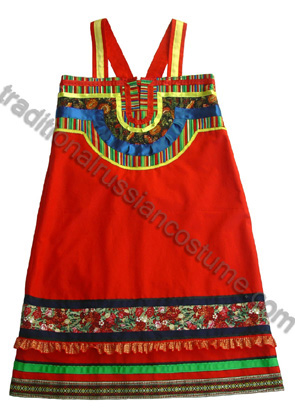
| Outfits >>> Replicas >>> Teenage girl's sarafan. | ||

|
| |
|
When we announced "a Kharkov-style sarafan", our Ukrainian friend replied angrily: "Nonsence! There is no such a thing! Kharkov women have worn poneva-skirts, no sarafans!" Generally speaking, she is right. Originally, a Kharkov woman's outfit included a poneva-skirt and an apron or nagrudnik (a kind of a jacket made of cotton or hemp). A sarafan came to Kharkov region around 1790s- 1810s only, due to, as scientists say, "a cultural diffusion" from Northern Russia. Southern Russians considered Northern regions to be advanced and rich ones. So, "a Northern outfit" was thought as an extremely fancy and up-to-date one. Therefore, it became an outfit of young brides-to-be (brides-to-be and grooms-to-be supposed to be dressed extremely expensive, fancy, and stylish). And, contrary, right after a wedding ceremony a just-married woman put on a poneva-skirt along with a soroka-headcover. Such a costume became an indicator of a married status. A paradigm of this sarafan was made of a blue factory-made kitaika (a kind of a cotton). At the second half of the 19th century a factory-made cloth was very expencive. Thus, it fit perfectly for a young girl's showing-off. However, nowadays cotton is cheap. And, we decided to accentuate a wearer's youth and beauty by using a red color. According to an archaic color-code, red color in a girl's outfit symbolizes maturity and a surplus of a vital energy. It has to be emphasized that a design of a Kharkov sarafan is the unique one. A semicircular applique of multicolored cloths have never been founded in any other region of Russia. | ||
Sources (in Russian)
| ||